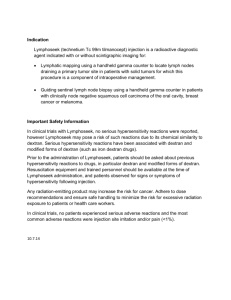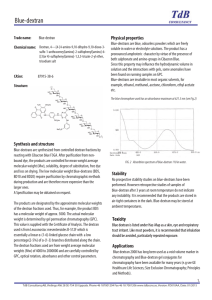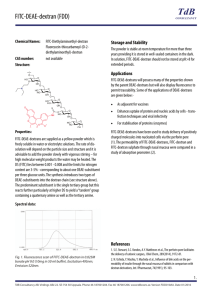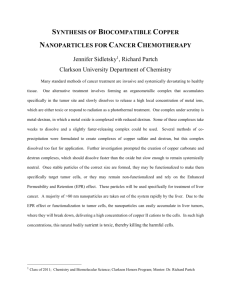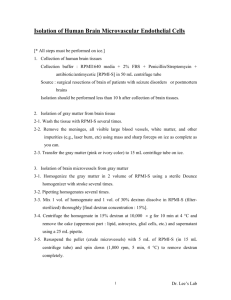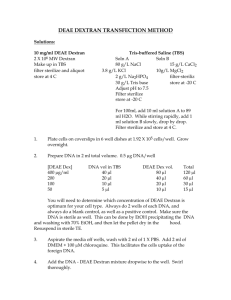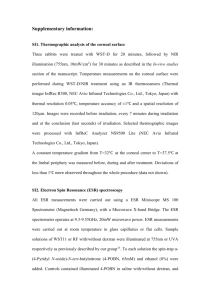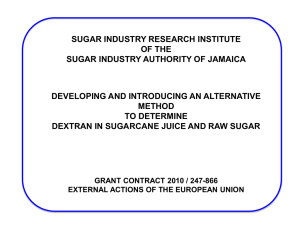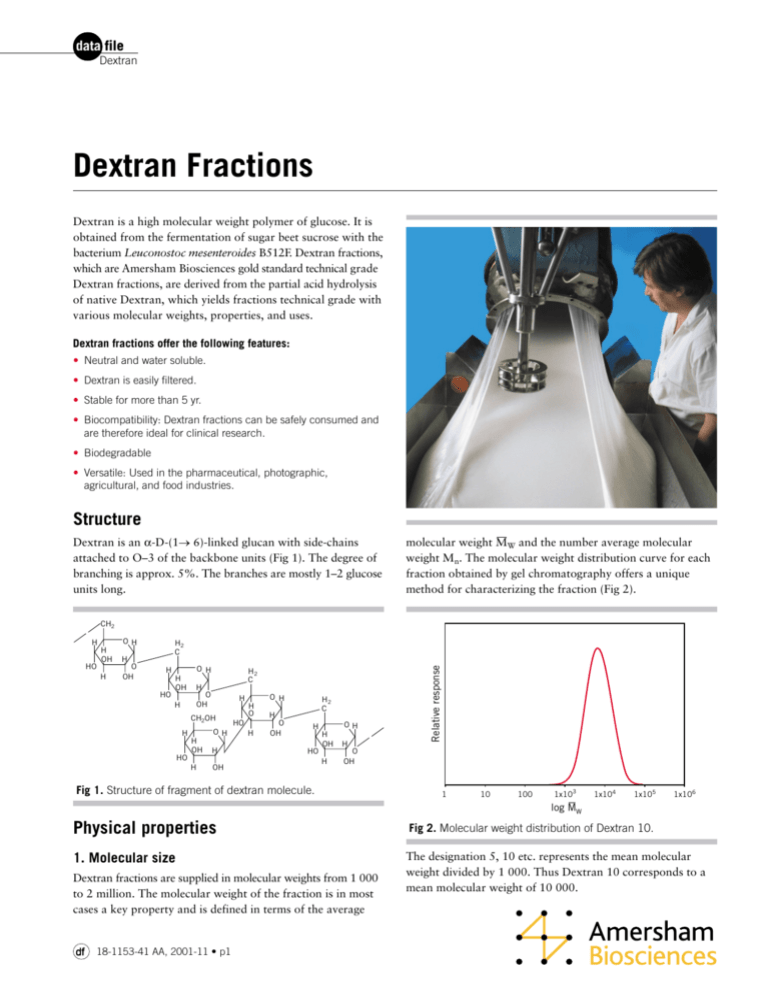
data file
Dextran
Dextran Fractions
Dextran is a high molecular weight polymer of glucose. It is
obtained from the fermentation of sugar beet sucrose with the
bacterium Leuconostoc mesenteroides B512F. Dextran fractions,
which are Amersham Biosciences gold standard technical grade
Dextran fractions, are derived from the partial acid hydrolysis
of native Dextran, which yields fractions technical grade with
various molecular weights, properties, and uses.
Dextran fractions offer the following features:
• Neutral and water soluble.
• Dextran is easily filtered.
• Stable for more than 5 yr.
• Biocompatibility: Dextran fractions can be safely consumed and
are therefore ideal for clinical research.
• Biodegradable
• Versatile: Used in the pharmaceutical, photographic,
agricultural, and food industries.
Structure
Dextran is an a-D-(1→ 6)-linked glucan with side-chains
attached to O–3 of the backbone units (Fig 1). The degree of
branching is approx. 5%. The branches are mostly 1–2 glucose
units long.
molecular weight MW and the number average molecular
weight Mn. The molecular weight distribution curve for each
fraction obtained by gel chromatography offers a unique
method for characterizing the fraction (Fig 2).
CH2
OH
H
OH
H
H
O
OH
HO
H2
C
O H
H
H
OH
H
H
O
OH
HO
H2
C
CH2OH
OH
H
H
OH
H
HO
H
O H
H
H
O
H
H
O
OH
HO
H2
C
OH
H
H
OH
H
H
O
OH
HO
OH
Fig 1. Structure of fragment of dextran molecule.
Relative response
H
1
10
100
1x103
1x104
1x105
1x106
log MW
Physical properties
Fig 2. Molecular weight distribution of Dextran 10.
1. Molecular size
The designation 5, 10 etc. represents the mean molecular
weight divided by 1 000. Thus Dextran 10 corresponds to a
mean molecular weight of 10 000.
Dextran fractions are supplied in molecular weights from 1 000
to 2 million. The molecular weight of the fraction is in most
cases a key property and is defined in terms of the average
df
18-1153-41 AA, 2001-11 • p1
Dextran
Dextran fractions behave as very flexible and extended
polymers and in solution exist as an expandable coil. The
molecular dimensions of some Dextran fractions are shown
in Table 1.
Example
A Dextran 40 solution (approx. 25%) is readily filtered through
a 1µm filter at temperatures between 60–80 °C. This solution
will also pass more slowly through a 0.45 µm filter.
Table 1. Molecular dimensions (Stoke's radius) of Dextran.
4. Viscosity
Stoke's radius (nm)
2 000
27
1 000
19.9
500
14.7
200
9.5
100
6.9
70
5.8
50
4.95
40
4.45
10
2.36
2. Solubility
Dextran fractions are readily soluble in water and electrolyte
solutions to form clear, stable solutions. The pH does not affect
solubility significantly. Concentrated solutions (> 50% w/v)
may be prepared.
Example
A stainless steel turbine stirrer (20 cm diameter) is mounted in
a 5 l beaker. Water (3 l) is added to the beaker and Dextran 40
(800 g) is added slowly over 10 min. The stirrer is maintained
at 600–800 rpm. A clear solution is obtained after 20 min.
Dextran fractions are also soluble in some other solvents,
notably, methyl sulfoxide, formamide, ethylene glycol, and
glycerol. Dextran fractions are insoluble in monohydric
alcohols, e.g. methanol, ethanol and isopropanol, and also
most ketones, e.g. acetone and 2-propanone.
Dextran fraction solutions exhibit Newtonian flow
characteristics i.e. the flow rate is independent of shear stress.
Figure 3 shows the dependence of viscosity on concentration
for Dextran fractions at 25 °C.
As Dextran is a neutral polysaccharide, the viscosity is not
significantly influenced by changes in pH or salt concentration.
10 000
1 000
Viscosity, cP
MW x 10-3
100
10
1
0
10
20
30
40
Concentration, %
5
40
110
10
70
500
2000
Although Dextran fractions will form clear solutions, it
should be noted that the lowest molecular weight fractions 5
and 10 may, on standing, form turbid solutions particularly
when concentrated solutions are used. This effect may be
delayed by boiling the solutions immediately after
preparation.
Fig 3. Dependence of viscosity of Dextran fractions on
concentration. Shear viscosity was measured at 25 °C.
3. Filtration
5. Colloid osmotic pressure of Dextran fraction
solutions
Dextran fraction solutions can be filtered without difficulty.
More concentrated solutions will require larger filters or filter
series and higher pressures in order to increase the rate of
filtration. Further increases in filtration rates may be achieved
by raising the temperature to between 60–80 °C. The dimensions
of the filter system must be related to the volume and
concentration of the Dextran solution used.
df
18-1153-41 AA, 2001-11 • p2
The colloid osmotic pressure is important for many applications
using Dextran. When comparing osmotic pressures, it is
important that the molecules do not pass through the
membrane with which they are in contact. For similar solute
concentrations, osmotic pressure will be largely dependent on
the molecular weight of the solute. Since Dextran is a neutral
polymer with large dimensions, it will not easily permeate
many human tissues and will thus maintain a favorable
osmotic environment unlike, for example, saline which
Dextran
readily diffuses into cells and tissues. A comparison of colloid
osmotic pressure for Dextran fractions 40 and 70 is shown in
Figure 4.
a slight decrease in pH and a slight yellowing may be observed,
which does not affect Dextran fraction solutions or
performance. The sterilization of Dextran solutions does not
affect the molecular weight distribution of the Dextran.
The autoclaving protocol for Dextran fraction solutions will
depend on many variables, for example:
10 000
Dextran 40
• Size of container
Dextran 70
• Container material
COP, Pa
• Packing of the autoclave
• Duration of heating and cooling
5 000
• Other components present
Solutions of Dextran fractions may also be sterilized by sterile
filtration. Other techniques, for example, irradiation may
lead to degradation.
Biocompatibility
0
1
2
3
4
5
Concentration, %
Fig 4. Colloid osmotic pressure of Dextran 40 and 70.
6. Specific optical rotation
[a]D = +195 – +201 ° (at 25 °C in water)
where [a] is the specific optical rotation measured in the
sodium D line.
Below approx. 20 000, the specific optical rotation decreases
with decreasing molecular weight.
Stability
1. Dry substance
Dextran fractions are stable for more than 5 yr when stored
as a dry powder in well-sealed containers at room temperature.
The powder will slowly absorb moisture when exposed to air
or when stored in non-air tight containers.
2. Dextran solutions
Dextran solutions may be sterilized by heating in an autoclave.
These solutions are stable for many years and are best stored at
a constant temperature. The optimal pH for storage is between
6 and 7. However Dextran is stable at room temperature for
extended periods in the pH range 4–10. During autoclaving
df
18-1153-41 AA, 2001-11 • p3
The clinical use of Dextrans over the past 50 yr provides
impressive proof of their safety and quality. Most of the
safety studies are related to parenterally administered Dextran
solutions in the MW range 40 000 to 70 000. The intravenous
mean lethal dose of Dextran fraction 70 is 55 g/kg bodyweight
in mice, 18 g/kg bodyweight in rabbits, and 10 g/kg bodyweight
in dogs.
Dextran may be ingested orally and is well tolerated.
The ingestion of Dextran is followed by a rapid increase in
blood sugar and liver glycogen and is thus digestible.
Many other applications of Dextran in medicine have
appeared. Dextran is an ingredient of solutions for ophthalmic
use, for intrauterine examinations, and is also used in creams
and ointments. It may therefore be concluded that Dextran
has an excellent record of biocompatibility.
Biodegradability
Enzymes (dextranases) from molds such as Penicillium and
Verticillium have been shown to degrade Dextran (1). The
products are essentially low molecular weight sugars, for
example, glucose, isomaltose etc. Similarly many bacteria
produce extracellular dextranases that split Dextran into low
molecular weight sugars (2). Examples of these are
Lactobacillus, Cellvibrio, Cytophaga, and soil Bacillus spp.
Dextran is therefore biodegradable and the Dextran biproducts
are readily absorbed into the natural environment.
Dextran
Product applications
Wet stabilization
Cosmetic ingredients
The addition of Dextran in concentrations up to 20% has
been shown to improve the stability of sensitive biomolecules
in solution.
Dextrans offer many attractive features as ingredients for
cosmetics:
• Neutral, water-soluble substances.
Two-phase separations
Aqueous two-phase systems have proved successful for
separating mixtures of biomolecules and sub-cellular particles.
Dextran concentrations of up to approximately 6% in
combination with polyethyleneglycol solutions have been
employed to fractionate nucleic acids, viruses, enzymes, and
other proteins (6,7).
• Natural products from renewable resources.
• Excellent biocompatibility and clinical safety record.
• High purity and good availability.
• Superior moisturizing properties.
• Viscosity independent of pH and shear.
Dextran fractions have already found use as excipients in
pharmaceutical formulations such as creams and ointments.
Stabilizers
Dextran has been found to stabilize enzymes, microrganisms,
and cells during lyophilization and vacuum drying. A particular
field of application that has received much attention is the
stabilization of vaccines.
Perfusion solutions
The addition of Dextran to solutions for perfusing viable
organs prior to cold storage confers many benefits; cell
integrity is maintained, cell swelling is minimized, and cells
are protected from free radical injury. Thus the use of Dextran
has been recommended in the perfusion and preservation of
kidney, liver, and cornea (8–10). Dextran may replace donor
plasma in priming solutions for heart-lung perfusion in open
heart surgery.
Dry stabilization
Dextran provides a novel method for the biopreservation of
labile biomolecules in the dry state (Fig 5). The process is
based on the addition of Dextran or similar materials and
conversion to the glassified state during drying (3).
The addition of Dextran as a cryoprotectant during freezethaw and freeze-drying operations has been extensively
documented (4,5).
A concentrated solution (32%) of Dextran fraction 70 in
glucose solution facilitates diagnostic and operative
hysteroscopy (11). Soluble low molecular weight Dextran
(Dextran 20) may interfere with the development of plaque
by inhibiting the adherence of bacteria to the dental enamel
and by inhibiting the synthesis of insoluble glucan by
glucosyltransferases in the oral cavity (12). This suggests a
number of applications in products for the oral-care sector.
AO-control
AO-dextran
100
Rel.activity, %
Dextrans are used widely as ingredients for ophthalmic
formulations, for example, artificial tears and eye drops. The
presence of Dextran helps to confer a favorable physiological
environment largely due to the colloid osmotic properties.
These solutions have now been in use for more than 10 years
and further testify to the excellent safety record of Dextran.
Other applications
120
80
60
40
20
Food industry
0
0
10
20
30
Time, h
Fig 5. Dry stabilization of alcohol oxidase (AO) with Dextran 500.
df
Ophthalmic applications
18-1153-41 AA, 2001-11 • p4
Ingestion of Dextran B512F produces a rapid increase in blood
sugar and liver glycogen (13). After ingestion of 0.67 g/kg
bodyweight, the blood sugar level in fasted humans rose by
23% at 30 min. No Dextran was detectable in feces (14,15).
Dextran
Nevertheless there can be little doubt on the safety of Dextran
when ingested orally. The potential application of Dextran in
ice-cream has been investigated (16). Recent studies have
shown that glucose uptake by brush-border mucosa is
enhanced after exposure to Dextran (17).
4) Amino- and carboxyl derivatives of Dextran
Numerous research groups have exploited the conjugation of
biologically active substances by way of amino (23) or
carboxyl (24) derivatives of Dextran. The conjugation is
performed using any one of the standard techniques for
synthesizing amide linkages.
Dextran conjugates
The synthesis and biological properties of Dextrans conjugated
to bioactive substances has become a vigorous field of
research. Dextran conjugates may offer a solution to many
problems confronted in drug design. Dextran conjugates can:
• Enhance solubility of sparingly soluble drugs.
• Enhance stability of sensitive drugs.
• Increase plasma half-life of the conjugate.
The toxicity of the conjugate will in general be much less than
the active drug.
Dextran fractions are ideally suited for this technology in that
they are neutral, water soluble, and biocompatible substances
readily available in high purity.
Conjugation techniques
1) Periodate oxidation
Oxidation of Dextran with periodate leads to the introduction
of dialdehyde groups that react with amino-groups in, for
example, proteins to form Schiff's bases. The latter can then
be stabilized by reduction with cyanoborohydride. These
operations are relatively simple and can be performed in
aqueous solution (18,19).
2) Cyanogen bromide
This procedure first reported by Porath and co-workers offers
a mild procedure for coupling in aqueous solution (20). The
reagent, cyanogen bromide, is highly toxic however and may
be replaced by the less hazardous reagent 1-cyano-4dimethylamino pyridinium tetrafluoro-borate (CDAP) (21).
3) Oxiranes
Oxirane groups may be introduced by reaction with
epichlorohydrin (22) or by means of a difunctional oxirane.
These reactions confer certain risks for cross-linking of the
Dextran chains.
df
18-1153-41 AA, 2001-11 • p5
5) Esters of Dextran
The synthesis and properties of esters of various non-steroidal
anti-inflammatory drugs and Dextran have been studied in
considerable detail (25).
Iron-Dextran complexes
Colloidal Dextran complexes with iron (26) and Dextran
complexes with gadolinium (27) are proving of considerable
value in magnetic resonance imaging techniques for detecting
tumours. Colloidal iron complexes are used widely for
treating anemia in new born piglets and calves (28).
Dextran 10, 5, and 3.5 are recommended for complexing
with iron.
Dextran
References
The following reviews cover various aspects of Dextran and
its properties.
"Dextran", de Belder, A.N. Pharmacia, Uppsala, Sweden (1990).
"Dextran", de Belder, A.N. in "Industrial Gums" (Whistler, R.L. and BeMiller, J.N. eds.)
Academic Press, New York, 2nd ed., pp.399–426 (1993).
"Medical Applications of Dextran and its Derivatives", de Belder, A.N. in "Polysaccharides in
Medicinal Applications" (Dumitriu, S. ed.) Marcel Dekker, New York, pp 505–524 (1996).
1. Tsuchiya, H.M., Allene Jeanes, Bricker, H.M., Wilham, C.A. J Bacteriol,64, 513–519
(1952).
Ordering information
Product
Dextran 1 (MW 1000)
Code No.
5 kg
30 kg
10-1663-05
10-1663-01
For larger volumes please contact your local representative
Dextran 3,5 (MW 3500)
40 kg
10-1657-01
Dextran 5 (MW 5000)
100 g
500 g
5 kg
10-1654-04
10-1654-05
10-1654-06
2. Zevenhuizen, L.P.T.M. Carbohydr Res, 6, 310–318 (1968).
3. Franks, F. and Hatley, R.H.M. U.S. Patent. 5 098 893 (1990).
Pack size
For larger volumes please contact your local representative
4. Hora, M.S., Rana, R.K. and Smith, F.W. Pharm Res, 9, 33–36 (1992).
5. Miles Inc., U.S. Patent 384584 (1989).
Dextran 10 (MW 10 000)
6. Albertsson, P.A. "Partition of Cell Particles and Macromolecules", 3rd ed., Wiley,
New York (1986).
7. Walter, H., Brooks, D.E. and Fischer, D. "Partitioning in Aqueous Two-Phase SystemsTheory, Methods, Uses and Applications to Biotechnology", Academic Press, New York
(1985).
8. Schlump, R., Morel, Ph., Loveras, J.J. et al, Transplantation Proc, 23, 657– 659 (1991).
11. Edström, K. and Fernström, J. Acta Obstet Gynec Scand, 49, 327–332 (1970).
Dextran 20 (MW 20 000)
100 g
500 g
5 kg
17-5239-01
17-5239-02
17-5239-03
For larger volumes please contact your local representative
Dextran 40 (MW 40 000)
12. Gibbons, R.J. and Keyes, P.H. Archs Oral Biol, 14, 721–724 (1969).
13. Jeanes, A. ACS Symposium Series, 15, 336–347 (1975).
14. McCurdy, R.D., Goff, H.D. and Stanley, D.W. Food Hydrocolloids, 8, 625–633 (1994).
17-0250-01
17-0250-02
17-0250-03
For larger volumes please contact your local representative
9. Howden, B.O., Jablonski, P., Thomas, A.C., Walls, K., Biguzas, M., Scott, F.D.F.,
Grossman, H. and Marshall, V.C. Transplantation, 49, 869–874 (1990).
10. Reim, M., Hesse, R. and Pietruscka, G. Klin Monatsbl Augenheilk, 196, 76–80 (1990).
100 g
500 g
5 kg
100 g
500 g
5 kg
17-0270-01
17-0270-02
17-0270-03
For larger volumes please contact your local representative
15. Bloom, W.L. and Wilhelmi, A.E. Fed Proc, 16, 478 (1957).
16. T.M.Parkinson, Nature (London), 215, 415 (1967).
Dextran 70 (MW 70 000)
17.
18. Foster, R.L. Experentia, 31, 772–773 (1975).
19. Adachi, S., Ogata, M., Tobita, H. and Hashimoto, K. Enzyme Microb Technol, 6,
259–262 (1984).
20. Axen, R., Porath, J. and Ernbach, S. Nature, 214, 1302–1304 (1967).
100 g
500 g
5 kg
For larger volumes please contact your local representative
Dextran 110 (MW 110 000)
21. Kohn, J. and Wilchek, M. FEBS Lett, 154, 209–210 (1983).
500 g
5 kg
22. Porath, J. and Fornstedt, N. J Chromatog, 31, 479–489 (1970).
For larger volumes please contact your local representative
23. Sundberg, L. and Porath, J. J Chromatog, 90, 87–98 (1974).
Dextran 500 (MW 500 000)
24. Schechter, B., Rosing, M.A., Wilchek, M. and Arnon, R. Cancer Chemother Pharmacol,
24, 161–166 (1989).
25. Larsen, C. Thesis, Royal Danish School of Pharmacy, Copenhagen (1990).
26. Winter, T.C., Freeny, P.C., Nghiem, H.V., Mack, L.A., Patten, R.M., Thomas, C.R. and
Elliot, S. Am J Roentgenol, 161, 1191–1198 (1993).
27. Guerbet, S. A. Eur. Patent 0344202B1 (1988).
17-0280-01
17-0280-02
17-0280-03
100 g
500 g
5 kg
17-0290-02
17-0290-03
17-0320-01
17-0320-02
17-0320-03
For larger volumes please contact your local representative
Dextran 2000 (MW 2 000 000)
28. Kolb, E. and Hoffman, U. Monatsh Veterinaermed, 44, 497–50 (1989).
100 g
500 g
5 kg
17-0330-01
17-0330-02
17-0330-03
For larger volumes please contact you local representative
Dextran CB
40 kg
10-1659-01
to order:
Asia Pacific Tel: +852 2811 8693 Fax: +852 2811 5251 Australasia Tel: +61 2 9894 5152 Fax: +61 2 9899 7511 Austria Tel: 01 57 606 1620 Fax: 01 57 606 1627 Belgium Tel: 0800 73 888 Fax: 03 272 1637
Canada Tel: 1 800 463 5800 Fax: 1 800 567 1008 Central, East, South East Europe Tel: +43 1 982 3826 Fax: +43 1 985 8327 Denmark Tel: 45 16 2400 Fax: 45 16 2424 Finland Tel: 09 512 3940 Fax: 09 512 1710
France Tel: 0169 35 67 00 Fax: 0169 41 96 77 Germany Tel: 0761 4903 401 Fax: 0761 4903 405 Italy Tel: 02 27322 1 Fax: 02 27302 212 Japan Tel: 81 3 5331 9336 Fax: 81 3 5331 9370
Latin America Tel: +55 11 3667 5700 Fax: +55 11 3667 87 99 Middle East and Africa Tel: +30 (1) 96 00 687 Fax: +30 (1) 96 00 693 Netherlands Tel: 0165 580 410 Fax: 0165 580 401 Norway Tel: 23 18 5800
Fax: 23 18 6800 Portugal Tel: 01 417 7035 Fax: 01 417 3184 Russian Federation Tel: +7 (095) 232 0250,956 1137 Fax: +7 (095) 230 6377 South East Asia Tel: 60 3 724 2080 Fax: 60 3 724 2090
Spain Tel: 93 594 49 50 Fax: 93 594 49 55 Sweden Tel: +46 018 612 19 00 Fax: +46 018 612 19 10 Switzerland Tel: 01 802 81 50 Fax: 01 802 81 51 UK Tel: 0800 616 928 Fax: 0800 616 927
USA Tel: +1 800 526 3593 Fax: +1 800 329 3593
Amersham and Amersham Biosciences are trademarks of Amersham plc. Amersham Biosciences AB Björkgatan 30, SE-751 84 Uppsala, Sweden. Amersham Biosciences Amersham Place, Little Chalfont,
Buckinghamshire HP7 9NA, England. Amersham Biosciences Corp 800 Centennial Avenue, PO Box 1327, Piscataway, NJ 08855 USA. Amersham Biosciences Europe GmbH Munzinger Strasse 9, D-79111 Freiburg,
Germany. Amersham Biosciences Sanken Building, 3-25-1, Shinjuku- ku, Tokyo 169-0073, Japan. All goods and services are sold subject to the terms and conditions of sale of the company within the Amersham
group that supplies them. A copy of these terms and conditions is available on request. © Amersham Biosciences AB 2001 - All rights reserved.
df
18-1153-41 AA, 2001-11 • p6

